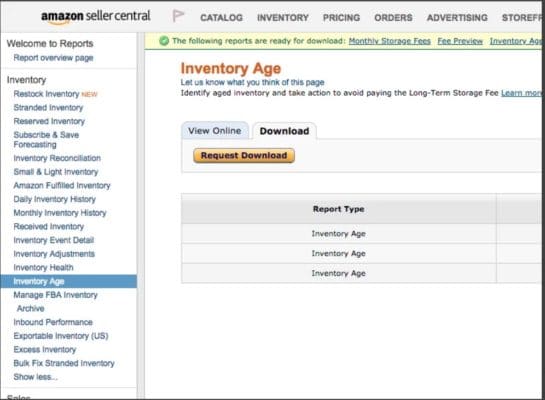NOTE: May 29th, 2018 was the last day to submit free Amazon removal orders (without the standard fee).
Amazon has recently announced that for a limited time sellers may remove their inventory for free, instead of the standard $.50 per unit removal fee.
It’s pitched as an incentive to help you to avoid long-term storage fees which will be assessed mid-August. Check out this handy tool in Seller Central to see your aging inventory and how many units exactly are subject to long-term storage fees in the near future. (screenshot below)

What Amazon is really doing with their limited-time offer of free removal orders is trying to clear out their warehouses to make room for new products which they anticipate will turn over more quickly. True, Amazon makes a tidy bundle on long-term storage fees twice yearly, but they likely do much better on genuine referral & selling fees from inventory that turns over many, many times within each six-month long-term storage fee window.
If you’re absolutely convinced there’s no way you can sell off your inventory that’s aging before the long-term storage fees are assessed, then this is a golden opportunity to remove those items to your home or other warehouse at no cost from Amazon.
The True Cost of “Free” Amazon Removals
Repeat: there’s no cost from Amazon. However if you have inventory at Amazon right now, that already means that you’ve accrued some costs, namely:
- The unit cost you paid your supplier
- As well as the shipping cost from your supplier to Amazon’s warehouse
- And any other costs as your goods made their way into Amazon’s FBA warehouses.
Let’s not forget you’re already out that money. By taking up Amazon on this offer to remove items at no further cost, you are accepting the unit cost & inbound shipping costs previously spent as complete losses. There’s no chance of recuperating those funds if you accept Amazons free removal offer and take those goods off Amazon’s marketplace.
What’s more, don’t forget the associated cost with storing those units somewhere instead of Amazon. If you take it to an ordinary storage facility you’ll be assessed monthly fees as well (though may be much cheaper than Amazon’s fees: mileage varies here). If you leave it in your basement, you’ll be assessed familial inconvenience fees & spousal complaints.
Upshot: there’s nothing free about free removals.
Amazon Removal Orders are Plan B. Sales are Plan A.
Upon learning this news that there is a free removal period opening up, I quickly tasked my VAs (Virtual Assistants) with creating a spreadsheet proposing the number of units to remove for each aging ASIN, based on the data they were able to retrieve from the tool in seller central here.
They were pleased to report how much money I would be saving in long-term storage fee assessment, by taking this and such free removals now.
After discussing the results, we came up with different bright idea: how about reducing the price on some of these ASINs which weren’t moving well, to see if we could organically (or via ads), move some of these units at a bit lower profit than originally desired – or at least break even!
Breaking even is not shameful. Breakeven actually means you receive an Amazon pay out, that is, at breakeven, the same number of dollars & cents that you originally put into the unit and its inbound shipping will finally be coming back to you. That’s a WIN. That’s much smarter than simply removing units to your basement, never recuperating the original value you sunk into them, and being reminded of that fact every time you trip over them forever.
Lower Retail Price vs. Amazon Removal Order
We tried lowering some prices and have successfully started to move ASINs that were either stuck or selling way too slowly – and by our projections, may well avoid all the long-term storage fees without “removing” a thing.
It doesn’t have to be too much work: just make a spreadsheet listing the ASINs, the number of units you need to sell off by mid-August, and some columns with notes about the price points you are testing day over day or week over week.
Then track each of these ASIN’s sales on the HelloProfit Dashboards to ensure each products’ new sales velocity will achieve your sales goals, thus avoiding those long-term storage fees. You can see the effect of your decisions detailed ASIN by ASIN right in your HelloProfit Payout Report.
You don’t even need to click “refresh” 50 times a day on your sales dashboards, because you can set sales velocity notifications on your products individually right in your HelloProfit account – so that you can, for example, be sent a text message or email when your sales hit an all-time high, or drop below a certain daily level. You can customize this all yourself – here’s how. Check it out in the video below.
The best part of all the Amazon removal order buzz: we’re now re-ordering new inventory of some ASINs we had thought we would simply be removing and killing off entirely, all because we lowered the price and got sales rolling again.
So what will it be? Make a removal and die, or get competitive and build an empire?


